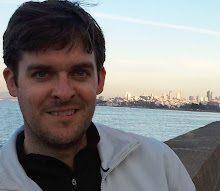“A device used for making a fair game crooked"
[original definition of the word GIMMICK, 1926].
– Maine & Grant’s “Wise-Crack Dictionary”
“Since 1984, the Criterion Collection, a continuing series of important classic and contemporary films, has been dedicated to gathering the greatest films from around the world and publishing them in editions that offer the highest technical quality and award-winning, original supplements.”
Rarely have I opened any critique with a quote from an outside source, but I find this a fitting opportunity to not only introduce one of the more popular home-video/DVD distribution centers at present, but to go on record as to reinforce this undisputed fact: that the Criterion Collection offers some of the finest, often hard-to-find enhanced editions of some of the most superior examples of World Cinema in the marketplace. Film enthusiasts and cine-snobs will not doubt concur that a Criterion disc is not only a highlight to any cinephile’s film library and makes for a nearly faultless purchase, but is in itself, a film school in a box, often complemented by stunning supplemental material and seldom-seen printed ephemera.
What puzzles me, however, is how a film like David Fincher’s THE CURIOUS CASE OF BENJAMIN BUTTON, was released this week (Tues., 5/5) as a Special Edition with so much immediacy under the Criterion banner. Like many others in the online world (see one thread here), I had seen the film, thoroughly disliked it and figured the snowballing buzz of the Criterion release was a sham - - during which time the film was still baiting the Academy and the film-going public with its surprising thirteen nominations for Oscar. Watching the 81st Academy Award Ceremony / telecast (Sun., 2/22) intently and privately hoping that Oscar gold would be granted to THE DARK KNIGHT (in my opinion, the strongest American film of 2008 on many levels), I was reminded of the sting I had once felt after failing to procure a successful job interview when BUTTON had garnered not one, but three wins in the categories of Art Direction, Makeup and Visual Effects. How ironic that the film was thus recognized in three ‘exterior’ and artificially-based categories as opposed to its fundamental and ‘interior’ cinematic traits e.g. screenwriting, directing and acting.
In his defense, David Fincher is one of the finest contemporary auteurs working in the film business whose stylistically visual stamp first seen in his television commercials and music videos is present in his feature film efforts. Just as Oliver Stone is adept at creating ‘’60’s films’, Hitchcock is the maestro of the ‘Suspense film’ and Jacques Tati is keen on crafting superbly, near-silent ‘Slapstick/Comedy films’, Fincher has dazzled in his construction of the Neo-Suspense film. His works are characteristic of a puzzle where his characters are pitted in ordinary landscapes amongst other characters where they engage in an extraordinary struggle for survival. Much like Michelangelo Antonioni’s films which utilize architecture and scenery as a character itself and whose films are reflective of the architecture of (the often times crumbling) relationships depicted, Fincher’s stories have been set against the backdrop of Victorian San Francisco or on rain-soaked streets of Los Angeles or inside the claustrophobic walls of an upscale Manhattan brownstone or in deep space.
How Fincher now ranks in the Criterion family amongst such cinematic masters as Cocteau, Renoir, Godard, Truffaut, Bunuel, Kurosawa, Fellini and Hitchcock for BENJAMIN BUTTON, this is, for lack of a better word, puzzling. Incidentally, Fincher’s finer works are monosyllabic in title (SE7EN, THE GAME) as is his visual masterwork, FIGHT CLUB and quite possibly his magnum opus, the under-appreciated ZODIAC, the latter being far more deserving of the Criterion stamp of approval.
THE CURIOUS CASE OF BENJAMIN BUTTON is nothing more than a gimmick; at first, an enticing premise that when once screened, is nothing more than a schmaltzy, superfluous, saccharine-induced, three-hour exercise in boredom - - about a man (-child) born in his eighties who ages backwards to his youth while simultaneously engaging in a morally improper relationship with a woman; a relationship so awkward and unconvincing because their chronological ages are constantly conflicting - - a film which, according to David Fincher “is about so many things”. Hear it from the horse’s mouth (4:40). How convenient the film was released on Christmas Day; hardly a present, this film deserves to go back into the sewing kit. Modeled as an adult bedtime story, the ‘Button’ in Brad Pitt’s portrayal of ‘Benjamin Button’ takes his name from his father, Thomas Button who works at - - a button factory(!?). And why open the film with a beautiful shower of buttons over the Warner Brothers logo? This effect has absolutely nothing to do with the film that follows. I suppose ‘Johnny Zipper’ would’ve been too shoddy a namesake for the film’s hero, but there is no etymological importance whatsoever to the naming of Fincher’s hero - - only that ‘Button’ sounds ‘cute’. What is wholly unbelievable about the film 1) besides Button’s trip to India and Cambodia which too closely resembles “Brangelina’s” current politics; 2) that Brad Pitt had personally commissioned the building of several homes in post-Katrina shaken New Orleans during the film’s production (where the film takes place, pre-Katrina) and 3) regarding the conception of Button and how similar in structure it is to Screenwriter, Eric Roth’s FORREST GUMP (see the parody) which speaks for itself. Quite possibly the film’s only redeeming quality is Alexandre Desplat’s magical, original score which was an absolute revelation; like a hark back to the films of yesteryear. Although it enhanced the film’s underlying sweetness and pretension, the notes (literally) were superior and an aural pleasure to inspire the imagination.
In the film's opening shot, an old woman is lying on her deathbed in a hospital with her daughter at her bedside while a storm surges outside of their window in modern-day New Orleans. Without delay, the woman asks her daughter to fetch her a diary so that she may read to her the story of Benjamin Button. And so Pandora’s box of tedium is opened with a flood of the woman’s and Benjamin’s shared memories cleverly camouflaged by magnificent visual effects. After a curiously enjoyable first hour that sets up the characters in Benjamin’s orbit, the dark specter of monotony (and Death) rears its ugly head enveloping the film like a hurricane circumventing the rain and wind-swept streets of New Orleans. From the film’s early moments in a train station wherein the unveiling of Monsieur Gateau’s backwards-moving clock reverse ticks to the opening voiceover monologue of Pitt’s Benjamin, “My name is Benjamin Button and I was born under unusual circumstances …”, we are introduced to an unusual style of non-linear editing that is not so much cleverly paced as it is a maddening collection of moments; most of which are all too reminiscent of FORREST GUMP and one finds it difficult to maneuver through sequences that appear tongue-in-cheek and/or handle sensitive moments of mortality with the delicacy of unleashing a bull into a china shop.
Like the shoemaker in Powell and Pressburger’s THE RED SHOES, one can’t help but wonder if the clockmaker’s strange technical contraption may be the impetus behind Benjamin’s unusual aging process. Perhaps he is a mad genius or a ‘Wizard’ of New Orleans’ ‘Oz’? More on this later. Perhaps it was fitting for Benjamin’s father to leave the aged child (who had minutes prior, been responsible for his mother’s death during childbirth) on the doorstep of a convalescent home where the patients immediately grow fond of the boy and take him in as one of their own. I couldn’t help but be reminded of Steve Martin’s naïve character in THE JERK who is adopted by an all black family although Button is surrounded by mostly octogenarians who learns from each of them until he’s brave enough to venture out alone into the world.
Benjamin progresses to his youth as his new friends are taken by death. Button meets a roommate who has been struck by lightning seven times in his life and we soon predictably realize that we will see each instance that the man is struck by a bolt of lightning. Benjamin meets Daisy (FORREST GUMP's Jenny?), the granddaughter of one of the patients in the home. Strangely, it’s love at first sight. When Benjamin is old enough to leave his adopted mother, Daisy asks him to write her wherever he goes. We discover that his postcards are stuffed in the pages of the diary from where the story is being told. Button matures, leaves home to enlist in the war effort before the Japanese bomb Pearl Harbor and later befriends a profane tugboat captain, Captain Mike (FORREST GUMP's Lt. Dan?), who has a penchant for booze, brothels and birds, most specifically, hummingbirds. Benjamin, like some strange manifestation of Death himself (MEET JOE BLACK, anyone?) seems to outlive each new acquaintance he meets and when Mike succumbs to his demise, he appears in the shape of a hummingbird before flying off screen. Meanwhile, in the film’s alternate universe, Daisy is blossoming into a professional dancer working with a dance troupe in Paris.
In another in a long line of Roth’ian ‘show and tell’ screenwriting tactics evident throughout the film (where we literally see everything we're told), we're soon to witness an obnoxiously drawn-out sequence depicting how in a series of random events, Daisy is hit by a cab, ending her career as a dancer. With just about every character out of the picture (they've literally died: Benjamin's father and adoptive mother, etc.) Benjamin and Daisy find that they've chronologically "met in the middle" and engage in several morally inappropriate acts of lovemaking. Although Benjamin's life and cycle of living appears all too fantastic, he is able to father a child (played by Pitt's real-life daughter) with Daisy.
I liken Fincher’s film’s force-of-nature, Hurricane Katrina, to the embodiment and spirit of THE CURIOUS CASE OF BENJAMIN BUTTON which manages to annihilate every relationship and leave every character in its wake as the film comes to a close - - and of all the random images we had seen throughout the film, our attention is laid to rest on the backwards-ticking clock in the basement of a storage room like some curio shop (FRIDAY THE 13TH: THE SERIES or RAIDERS OF THE LOST ARK) harboring some demonic device as water rushes in to engulf all of the objects in its path.
BENJAMIN BUTTON, you not only bore me, you downright scare me!







